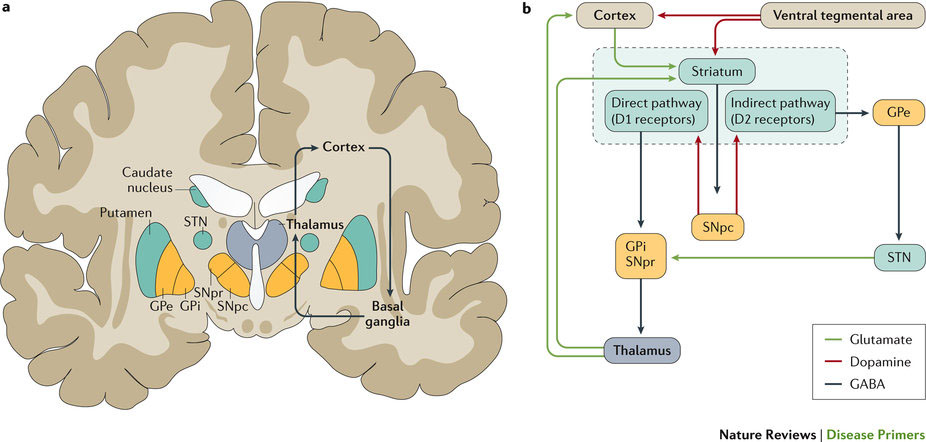ジル・ドゥ・ラ・トゥレット症候群
Gilles de la Tourette syndrome
2017年2月2日 Nature Reviews Disease Primers Article number: 16097 (2017) doi: 10.1038/nrdp.2016.97

ジル・ドゥ・ラ・トゥレット症候群(GTS)は小児期に発症する神経発達障害で複数の運動チックと音声チックを特徴とする。チック症状は通常10歳までに発症し、増悪と寛解を示しながら年齢とともに軽快することが多い。小児と思春期の有病率は約1%と推定されている。とりわけ、汚言症(暴言チック)や自傷行為のような重度のチック症状が現れる場合、あるいはGTSに注意欠如/多動性障害、強迫性障害またはその他の精神神経疾患が伴う場合には、重い社会的烙印が押されるだけでなくQOLも不良となる。GTSは、複雑で多因子性の病因を有し、希少性変異、遺伝性変異または新しい変異と複数のよく知られているリスク変異体との組み合わせで起こる多遺伝子性疾患とみられている。これらの要因だけでなく、周産期イベントや免疫学的因子などの非遺伝的因子も臨床的表現型の多様性、構造的および機能的脳異常、ならびに神経回路障害に寄与している可能性が高い。管理には、通常、心理教育と勇気づけ、行動療法、薬物療法、まれに機能的脳神経外科手術が行われる。今後、臨床データと神経イメージングや遺伝学などの神経生物学的データを統合することで、GTSの発症機構が神経回路レベルで解明され、標的治療の開発につながることが期待される。
PrimeView
ジル・ドゥ・ラ・トゥレット症候群(GTS)は神経発達障害で運動チックと1種以上の音声チックを特徴とする。チック症状は小児期に発症し、年齢とともに軽快する。このPrimeViewでは、GTSの臨床的特徴とQOLに及ぼす影響を中心に取りまとめる。
本Primerの図解サマリー
Gilles de la Tourette syndrome (GTS) is a childhood-onset neurodevelopmental disorder that is characterized by several motor and phonic tics. Tics usually develop before 10 years of age, exhibit a waxing and waning course and typically improve with increasing age. A prevalence of approximately 1% is estimated in children and adolescents. The condition can result in considerable social stigma and poor quality of life, especially when tics are severe (for example, with coprolalia (swearing tics) and self-injurious behaviours) or when GTS is accompanied by attention-deficit/hyperactivity disorder, obsessive–compulsive disorder or another neuropsychiatric disorder. The aetiology is complex and multifactorial. GTS is considered to be polygenic, involving multiple common risk variants combined with rare, inherited or de novo mutations. These as well as non-genetic factors (such as perinatal events and immunological factors) are likely to contribute to the heterogeneity of the clinical phenotype, the structural and functional brain anomalies and the neural circuitry involvement. Management usually includes psychoeducation and reassurance, behavioural methods, pharmacotherapy and, rarely, functional neurosurgery. Future research that integrates clinical and neurobiological data, including neuroimaging and genetics, is expected to reveal the pathogenesis of GTS at the neural circuit level, which may lead to targeted interventions.

